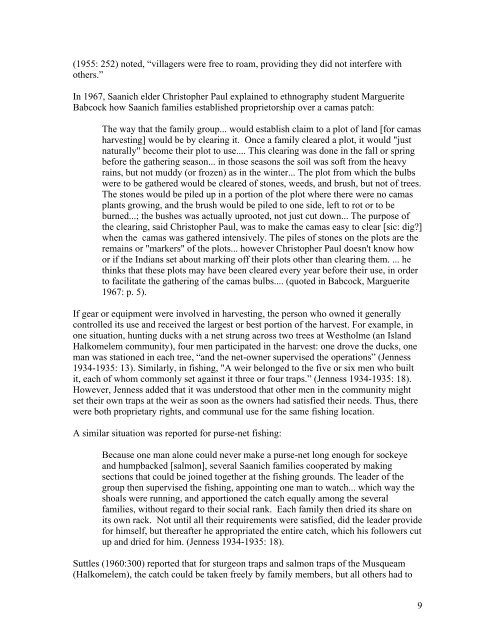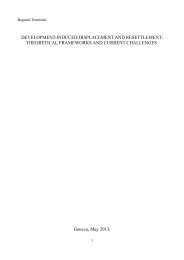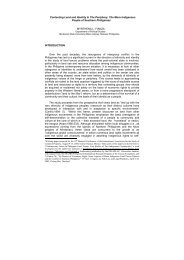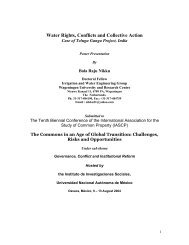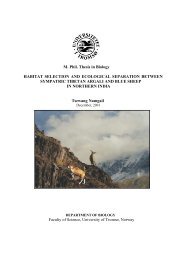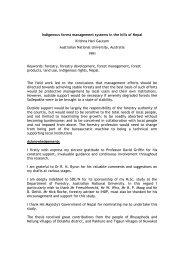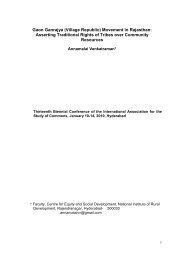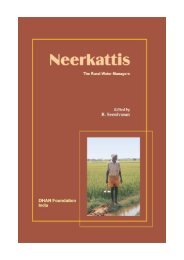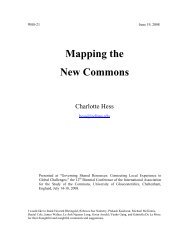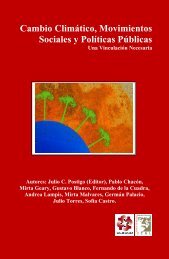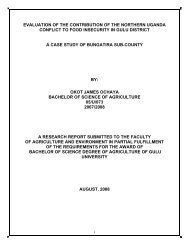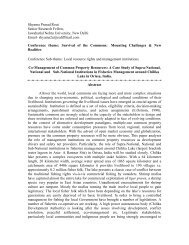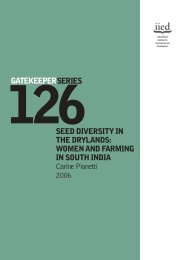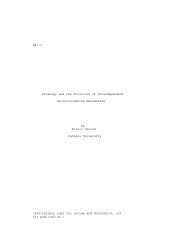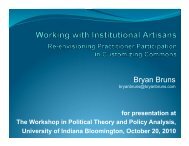Occupying the Land - Digital Library Of The Commons
Occupying the Land - Digital Library Of The Commons
Occupying the Land - Digital Library Of The Commons
Create successful ePaper yourself
Turn your PDF publications into a flip-book with our unique Google optimized e-Paper software.
(1955: 252) noted, “villagers were free to roam, providing <strong>the</strong>y did not interfere witho<strong>the</strong>rs.”In 1967, Saanich elder Christopher Paul explained to ethnography student MargueriteBabcock how Saanich families established proprietorship over a camas patch:<strong>The</strong> way that <strong>the</strong> family group... would establish claim to a plot of land [for camasharvesting] would be by clearing it. Once a family cleared a plot, it would "justnaturally" become <strong>the</strong>ir plot to use.... This clearing was done in <strong>the</strong> fall or springbefore <strong>the</strong> ga<strong>the</strong>ring season... in those seasons <strong>the</strong> soil was soft from <strong>the</strong> heavyrains, but not muddy (or frozen) as in <strong>the</strong> winter... <strong>The</strong> plot from which <strong>the</strong> bulbswere to be ga<strong>the</strong>red would be cleared of stones, weeds, and brush, but not of trees.<strong>The</strong> stones would be piled up in a portion of <strong>the</strong> plot where <strong>the</strong>re were no camasplants growing, and <strong>the</strong> brush would be piled to one side, left to rot or to beburned...; <strong>the</strong> bushes was actually uprooted, not just cut down... <strong>The</strong> purpose of<strong>the</strong> clearing, said Christopher Paul, was to make <strong>the</strong> camas easy to clear [sic: dig?]when <strong>the</strong> camas was ga<strong>the</strong>red intensively. <strong>The</strong> piles of stones on <strong>the</strong> plots are <strong>the</strong>remains or "markers" of <strong>the</strong> plots... however Christopher Paul doesn't know howor if <strong>the</strong> Indians set about marking off <strong>the</strong>ir plots o<strong>the</strong>r than clearing <strong>the</strong>m. ... hethinks that <strong>the</strong>se plots may have been cleared every year before <strong>the</strong>ir use, in orderto facilitate <strong>the</strong> ga<strong>the</strong>ring of <strong>the</strong> camas bulbs.... (quoted in Babcock, Marguerite1967: p. 5).If gear or equipment were involved in harvesting, <strong>the</strong> person who owned it generallycontrolled its use and received <strong>the</strong> largest or best portion of <strong>the</strong> harvest. For example, inone situation, hunting ducks with a net strung across two trees at Westholme (an IslandHalkomelem community), four men participated in <strong>the</strong> harvest: one drove <strong>the</strong> ducks, oneman was stationed in each tree, “and <strong>the</strong> net-owner supervised <strong>the</strong> operations” (Jenness1934-1935: 13). Similarly, in fishing, "A weir belonged to <strong>the</strong> five or six men who builtit, each of whom commonly set against it three or four traps.” (Jenness 1934-1935: 18).However, Jenness added that it was understood that o<strong>the</strong>r men in <strong>the</strong> community mightset <strong>the</strong>ir own traps at <strong>the</strong> weir as soon as <strong>the</strong> owners had satisfied <strong>the</strong>ir needs. Thus, <strong>the</strong>rewere both proprietary rights, and communal use for <strong>the</strong> same fishing location.A similar situation was reported for purse-net fishing:Because one man alone could never make a purse-net long enough for sockeyeand humpbacked [salmon], several Saanich families cooperated by makingsections that could be joined toge<strong>the</strong>r at <strong>the</strong> fishing grounds. <strong>The</strong> leader of <strong>the</strong>group <strong>the</strong>n supervised <strong>the</strong> fishing, appointing one man to watch... which way <strong>the</strong>shoals were running, and apportioned <strong>the</strong> catch equally among <strong>the</strong> severalfamilies, without regard to <strong>the</strong>ir social rank. Each family <strong>the</strong>n dried its share onits own rack. Not until all <strong>the</strong>ir requirements were satisfied, did <strong>the</strong> leader providefor himself, but <strong>the</strong>reafter he appropriated <strong>the</strong> entire catch, which his followers cutup and dried for him. (Jenness 1934-1935: 18).Suttles (1960:300) reported that for sturgeon traps and salmon traps of <strong>the</strong> Musqueam(Halkomelem), <strong>the</strong> catch could be taken freely by family members, but all o<strong>the</strong>rs had to9


